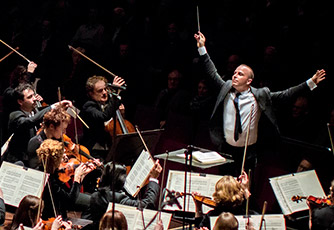
One of the best orchestras in the United States, the New York Philharmonic, is coming to town later this week and offering a bunch of festivities in the next few days.
The New York Philharmonic is visiting Ann Arbor for an adventurous five-year residency program with the University Musical Society (UMS) and the School of Music, Theater, and Dance (SMTD). As a result, the New York Phil personnel will be offering a lot of master classes, concerts, lectures, and even a halftime show at the Homecoming football game (!) in the next few days. Check them out:
THURSDAY, OCTOBER 8
Keynote Address: Orchestras in the 21st Century: A New Paradigm
6:00 pm, Rackham Auditorium, FREE
Join Maestro Alan Gilbert, the musical director of the New York Philharmonic, as he gives his keynote speech on the role of orchestras in the 21st century.
New York Philharmonic Residency Kickoff: Side-by-Side Concert
7:30pm, Rackham Auditorium, FREE
Eight students from the School of Music are playing chamber music with the New York Philharmonic musicians in this free concert. They have been rehearsing a lot and are sounding great already!
FRIDAY, OCTOBER 9
Public Master Classes
Time Varies, School of Music Moore Building (1100 Baits Dr.), FREE
Many musicians from the New York Philharmonic are giving master classes throughout the day. Check the link above to see if your favorite musician is giving one! All are open to public.
Lecture: 21st Century Orchestras and Social Impact
1:30 pm, Room R1240 of Ross School of Business, FREE
Come hear the President of the New York Philharmonic, Matthew VanBesien, talk about his view on how the orchestra can make a huge impact despite its challenges today.
New York Philharmonic – Performance 1
8:00 pm, Hill Auditorium
Friday night’s performance will consist of classical favorites including two works by Beethoven. Student tickets ($12 and $20) are slim, if not sold out, for this concert as of this writing.
SATURDAY, OCTOBER 10
New York Philharmonic – Performance 2
8:30 pm, Hill Auditorium, FREE with the Passport to the Arts
Saturday night’s performance explores some newer works, including one by the New York Philharmonic composer-in-residence, Esa Pekka Salonen. Student tickets ($12 and $20) are available at ums.org as well as the Michigan League Ticket Office, or you can also get a FREE ticket using the Passport to the Arts if redeemed before the night of the event!
SUNDAY, OCTOBER 11
Interview and Discussion with Vince Ford, director of digital media at the New York Philharmonic
9:30 am, Britton Recital Hall at the School of Music (1100 Baits Dr.)
Come hear Vince Ford, Director of Digital Media, talk about how digital media can be a great tool for marketing in this age. There will be breakfast served before the event as well.
Public Master Classes
Time Varies, School of Music Moore Building (1100 Baits Dr.), FREE
There will be another round of master classes by the musicians of the New York Philharmonic on Sunday. Check them out at the link above!
New York Philharmonic – Performance 3
3:00 pm, Hill Auditorium
The third and final performance by the orchestra for this year will feature “On the Waterfront” by Leonard Bernstein – the legendary composer and long-time conductor at the New York Philharmonic. This concert will be preceded by Dig In with UMS, where you can meet your fellow concertgoers in a casual setting with food and activities.
This is a very unique opportunity to see such a high-class orchestra for multiple days in multiple settings. Don’t miss out, Ann Arbor!










